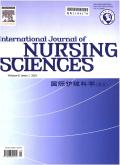Public participation willingness in out-of-hospital cardiopulmonary resuscitation: A systematic review and meta-analysis
IF 3.1
3区 医学
Q1 NURSING
引用次数: 0
Abstract
Objective
This systematic review and meta-analysis aimed to identify the main factors influencing the public’s willingness to participate in out-of-hospital emergency care.
Methods
Studies were searched in online databases, including PubMed, Embase, Web of Science, and the Cochrane Library. The articles included in this review were published from inception to July 31, 2024. The Iain Crombie assessment tool was used to assess study quality. Meta-analysis was performed using RevMan (version 5.4) software. The review protocol has been registered with PROSPERO (CRD42024570491).
Results
A total of 1,434 research articles were initially identified, among which 18 were incorporated into this study, and all of the included studies were cross-sectional. Meta-analysis results demonstrated that gender (male; OR = 1.37, 95%CI: 1.28–1.47), profession (healthcare provider; OR = 0.17, 95%CI: 0.06–0.47), knowledge and skill level (OR = 1.63, 95%CI: 1.25–2.11), willingness to undergo training (OR = 2.68, 95%CI: 1.89–3.79), interest in first aid (OR = 2.08, 95%CI: 1.60–2.69), previous training (OR = 2.14, 95%CI: 1.49–3.08), and previous first-aid experience (OR = 1.70, 95%CI: 1.37–2.11) were the principal influencing factors of the public’s willingness to engage in out-of-hospital cardiopulmonary resuscitation.
Conclusion
Demographic factors, knowledge, belief, and behavior are crucial in influencing public emergency decision-making. Medical personnel could create specialized training programs based on relevant factors to enhance the public's willingness to engage in out-of-hospital CPR.
院外心肺复苏公众参与意愿:系统回顾与荟萃分析
目的通过系统回顾和荟萃分析,探讨影响公众参与院外急救意愿的主要因素。方法在PubMed、Embase、Web of Science和Cochrane Library等在线数据库中检索研究。本综述纳入的文章发表时间为创刊至2024年7月31日。采用Iain Crombie评估工具评估研究质量。采用RevMan (version 5.4)软件进行meta分析。审查方案已在PROSPERO注册(CRD42024570491)。结果初步筛选出1434篇研究论文,其中18篇纳入本研究,纳入研究均为横断面研究。meta分析结果显示,性别(男性;OR = 1.37, 95%CI: 1.28-1.47),职业(医疗保健提供者;OR = 0.17, 95%CI: 0.06-0.47)、知识和技能水平(OR = 1.63, 95%CI: 1.25-2.11)、接受培训的意愿(OR = 2.68, 95%CI: 1.89-3.79)、对急救的兴趣(OR = 2.08, 95%CI: 1.60-2.69)、既往培训(OR = 2.14, 95%CI: 1.49-3.08)、既往急救经验(OR = 1.70, 95%CI: 1.37-2.11)是影响公众参与院外心肺复苏意愿的主要因素。结论人口因素、知识、信念和行为是影响突发公共事件决策的重要因素。医务人员可根据相关因素制定专门的培训方案,提高公众参与院外心肺复苏术的意愿。
本文章由计算机程序翻译,如有差异,请以英文原文为准。
求助全文
约1分钟内获得全文
求助全文
来源期刊

International Journal of Nursing Sciences
Nursing-Nursing (all)
CiteScore
6.10
自引率
2.60%
发文量
408
审稿时长
25 days
期刊介绍:
This journal aims to promote excellence in nursing and health care through the dissemination of the latest, evidence-based, peer-reviewed clinical information and original research, providing an international platform for exchanging knowledge, research findings and nursing practice experience. This journal covers a wide range of nursing topics such as advanced nursing practice, bio-psychosocial issues related to health, cultural perspectives, lifestyle change as a component of health promotion, chronic disease, including end-of-life care, family care giving. IJNSS publishes four issues per year in Jan/Apr/Jul/Oct. IJNSS intended readership includes practicing nurses in all spheres and at all levels who are committed to advancing practice and professional development on the basis of new knowledge and evidence; managers and senior members of the nursing; nurse educators and nursing students etc. IJNSS seeks to enrich insight into clinical need and the implications for nursing intervention and models of service delivery. Contributions are welcomed from other health professions on issues that have a direct impact on nursing practice.
 求助内容:
求助内容: 应助结果提醒方式:
应助结果提醒方式:


